University Statistics Assignment: Analyzing Data and Distributions
VerifiedAdded on 2023/06/10
|9
|924
|192
Homework Assignment
AI Summary
This statistics assignment analyzes a dataset focusing on age at enrollment and age at first arrest. It explores the skewness and kurtosis of distributions, comparing the original and smaller datasets. The assignment includes frequency distributions, descriptive statistics, and tests of normality such as Shapiro-Wilk and Kolmogorov-Smirnov. The student interprets the skewness and kurtosis, and discusses the appropriateness of statistical tests based on sample size, comparing results and explaining the differences. The assignment demonstrates an understanding of data analysis techniques, statistical concepts, and the application of these concepts using statistical software like SPSS.
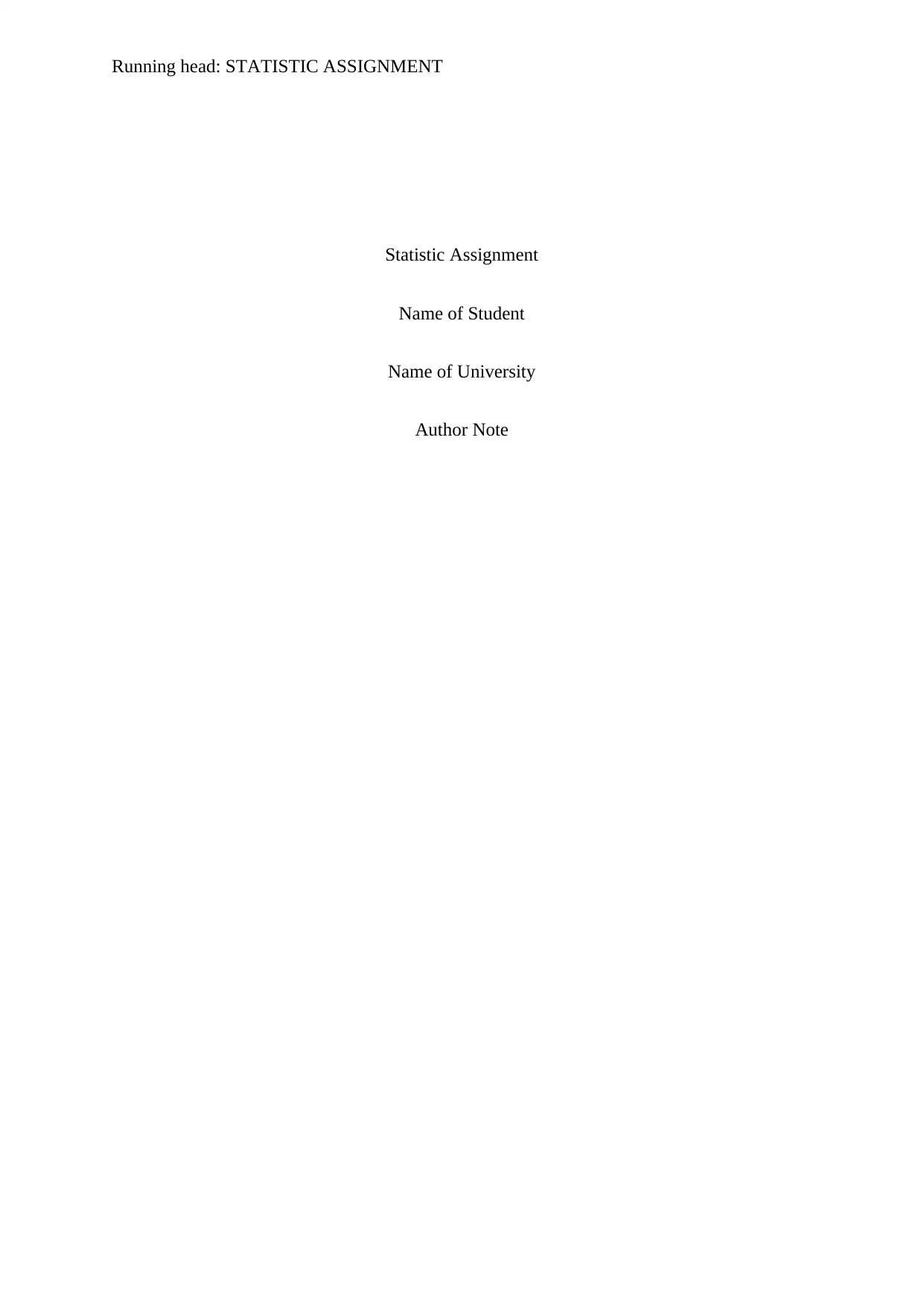
Running head: STATISTIC ASSIGNMENT
Statistic Assignment
Name of Student
Name of University
Author Note
Statistic Assignment
Name of Student
Name of University
Author Note
Paraphrase This Document
Need a fresh take? Get an instant paraphrase of this document with our AI Paraphraser

1STATISTIC ASSIGNMENT
Table of Contents
Q1...............................................................................................................................................2
Q2...............................................................................................................................................3
Q3...............................................................................................................................................3
Q4...............................................................................................................................................6
Q5...............................................................................................................................................6
Q6...............................................................................................................................................6
Q7...............................................................................................................................................7
Q8...............................................................................................................................................7
Q9...............................................................................................................................................8
Q10.............................................................................................................................................8
Table of Contents
Q1...............................................................................................................................................2
Q2...............................................................................................................................................3
Q3...............................................................................................................................................3
Q4...............................................................................................................................................6
Q5...............................................................................................................................................6
Q6...............................................................................................................................................6
Q7...............................................................................................................................................7
Q8...............................................................................................................................................7
Q9...............................................................................................................................................8
Q10.............................................................................................................................................8
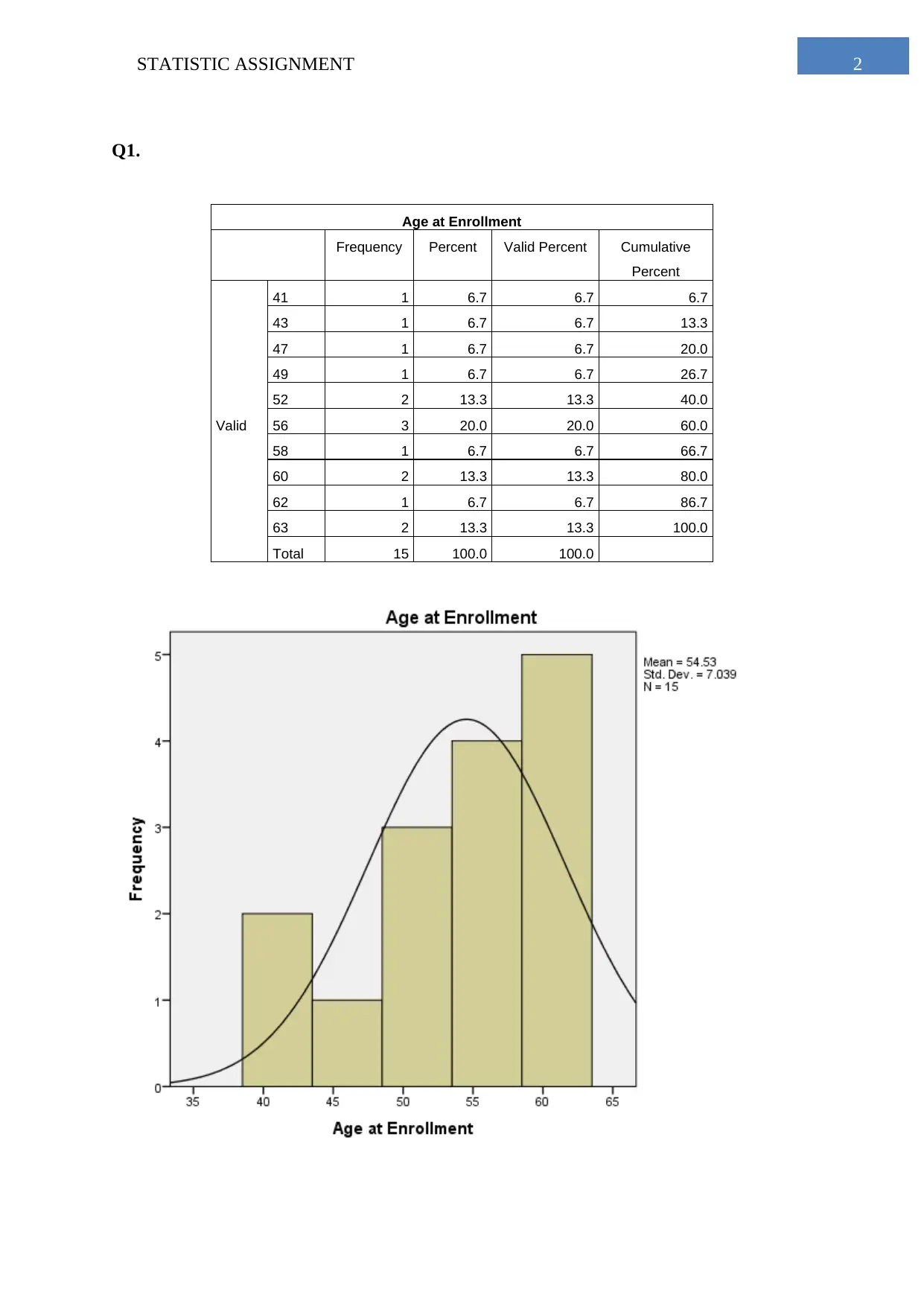
2STATISTIC ASSIGNMENT
Q1.
Age at Enrollment
Frequency Percent Valid Percent Cumulative
Percent
Valid
41 1 6.7 6.7 6.7
43 1 6.7 6.7 13.3
47 1 6.7 6.7 20.0
49 1 6.7 6.7 26.7
52 2 13.3 13.3 40.0
56 3 20.0 20.0 60.0
58 1 6.7 6.7 66.7
60 2 13.3 13.3 80.0
62 1 6.7 6.7 86.7
63 2 13.3 13.3 100.0
Total 15 100.0 100.0
Q1.
Age at Enrollment
Frequency Percent Valid Percent Cumulative
Percent
Valid
41 1 6.7 6.7 6.7
43 1 6.7 6.7 13.3
47 1 6.7 6.7 20.0
49 1 6.7 6.7 26.7
52 2 13.3 13.3 40.0
56 3 20.0 20.0 60.0
58 1 6.7 6.7 66.7
60 2 13.3 13.3 80.0
62 1 6.7 6.7 86.7
63 2 13.3 13.3 100.0
Total 15 100.0 100.0
⊘ This is a preview!⊘
Do you want full access?
Subscribe today to unlock all pages.

Trusted by 1+ million students worldwide
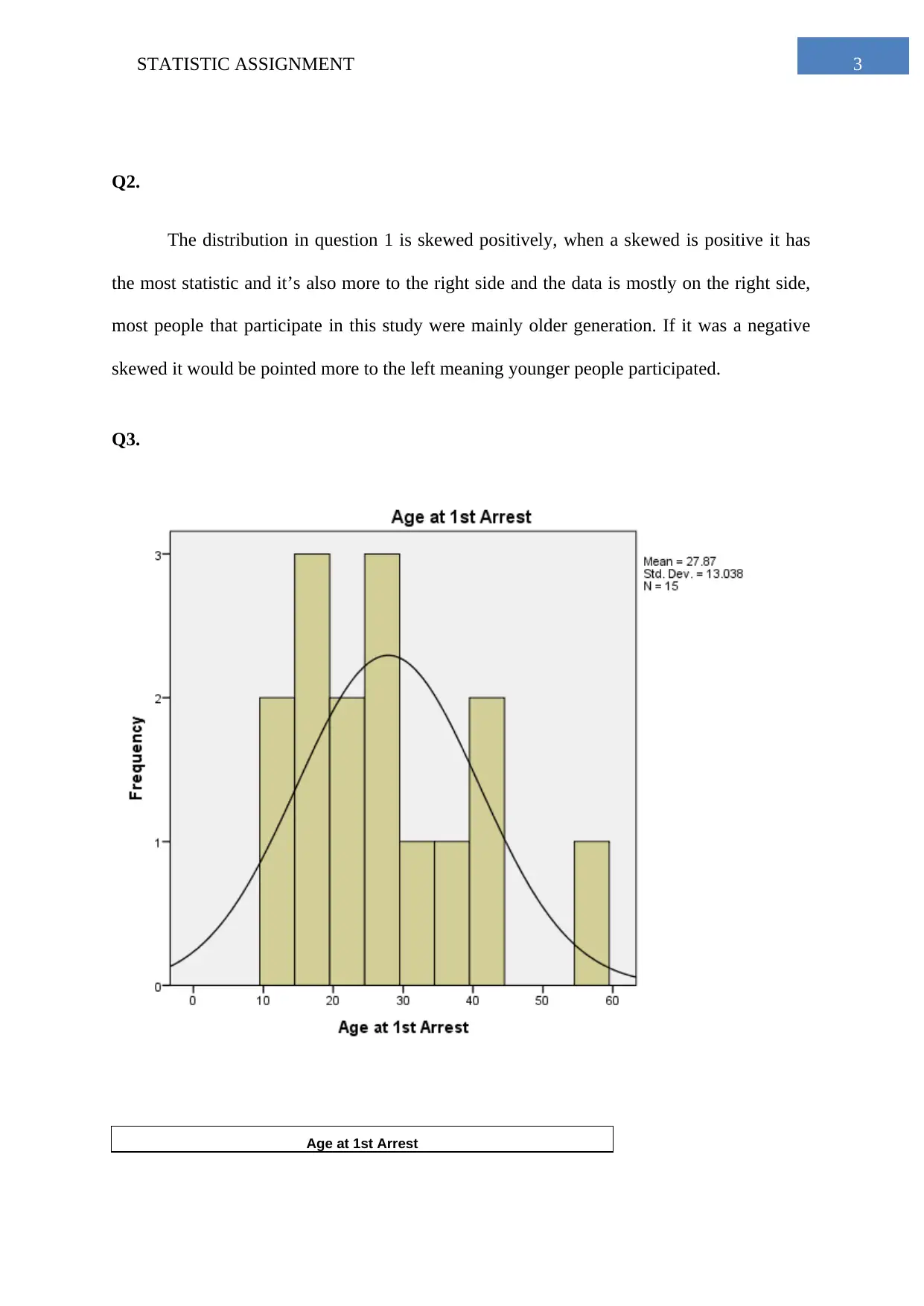
3STATISTIC ASSIGNMENT
Q2.
The distribution in question 1 is skewed positively, when a skewed is positive it has
the most statistic and it’s also more to the right side and the data is mostly on the right side,
most people that participate in this study were mainly older generation. If it was a negative
skewed it would be pointed more to the left meaning younger people participated.
Q3.
Age at 1st Arrest
Q2.
The distribution in question 1 is skewed positively, when a skewed is positive it has
the most statistic and it’s also more to the right side and the data is mostly on the right side,
most people that participate in this study were mainly older generation. If it was a negative
skewed it would be pointed more to the left meaning younger people participated.
Q3.
Age at 1st Arrest
Paraphrase This Document
Need a fresh take? Get an instant paraphrase of this document with our AI Paraphraser
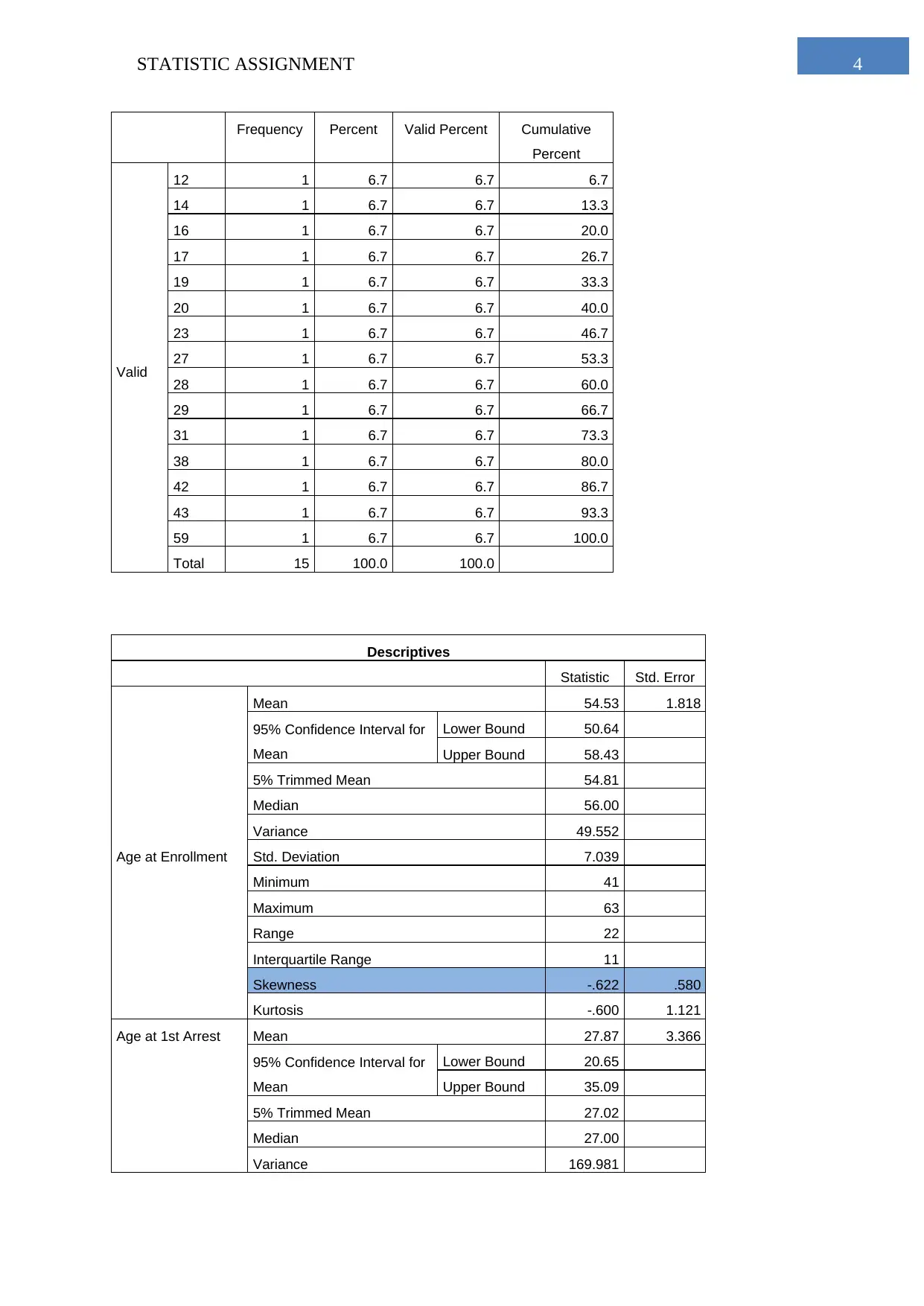
4STATISTIC ASSIGNMENT
Frequency Percent Valid Percent Cumulative
Percent
Valid
12 1 6.7 6.7 6.7
14 1 6.7 6.7 13.3
16 1 6.7 6.7 20.0
17 1 6.7 6.7 26.7
19 1 6.7 6.7 33.3
20 1 6.7 6.7 40.0
23 1 6.7 6.7 46.7
27 1 6.7 6.7 53.3
28 1 6.7 6.7 60.0
29 1 6.7 6.7 66.7
31 1 6.7 6.7 73.3
38 1 6.7 6.7 80.0
42 1 6.7 6.7 86.7
43 1 6.7 6.7 93.3
59 1 6.7 6.7 100.0
Total 15 100.0 100.0
Descriptives
Statistic Std. Error
Age at Enrollment
Mean 54.53 1.818
95% Confidence Interval for
Mean
Lower Bound 50.64
Upper Bound 58.43
5% Trimmed Mean 54.81
Median 56.00
Variance 49.552
Std. Deviation 7.039
Minimum 41
Maximum 63
Range 22
Interquartile Range 11
Skewness -.622 .580
Kurtosis -.600 1.121
Age at 1st Arrest Mean 27.87 3.366
95% Confidence Interval for
Mean
Lower Bound 20.65
Upper Bound 35.09
5% Trimmed Mean 27.02
Median 27.00
Variance 169.981
Frequency Percent Valid Percent Cumulative
Percent
Valid
12 1 6.7 6.7 6.7
14 1 6.7 6.7 13.3
16 1 6.7 6.7 20.0
17 1 6.7 6.7 26.7
19 1 6.7 6.7 33.3
20 1 6.7 6.7 40.0
23 1 6.7 6.7 46.7
27 1 6.7 6.7 53.3
28 1 6.7 6.7 60.0
29 1 6.7 6.7 66.7
31 1 6.7 6.7 73.3
38 1 6.7 6.7 80.0
42 1 6.7 6.7 86.7
43 1 6.7 6.7 93.3
59 1 6.7 6.7 100.0
Total 15 100.0 100.0
Descriptives
Statistic Std. Error
Age at Enrollment
Mean 54.53 1.818
95% Confidence Interval for
Mean
Lower Bound 50.64
Upper Bound 58.43
5% Trimmed Mean 54.81
Median 56.00
Variance 49.552
Std. Deviation 7.039
Minimum 41
Maximum 63
Range 22
Interquartile Range 11
Skewness -.622 .580
Kurtosis -.600 1.121
Age at 1st Arrest Mean 27.87 3.366
95% Confidence Interval for
Mean
Lower Bound 20.65
Upper Bound 35.09
5% Trimmed Mean 27.02
Median 27.00
Variance 169.981
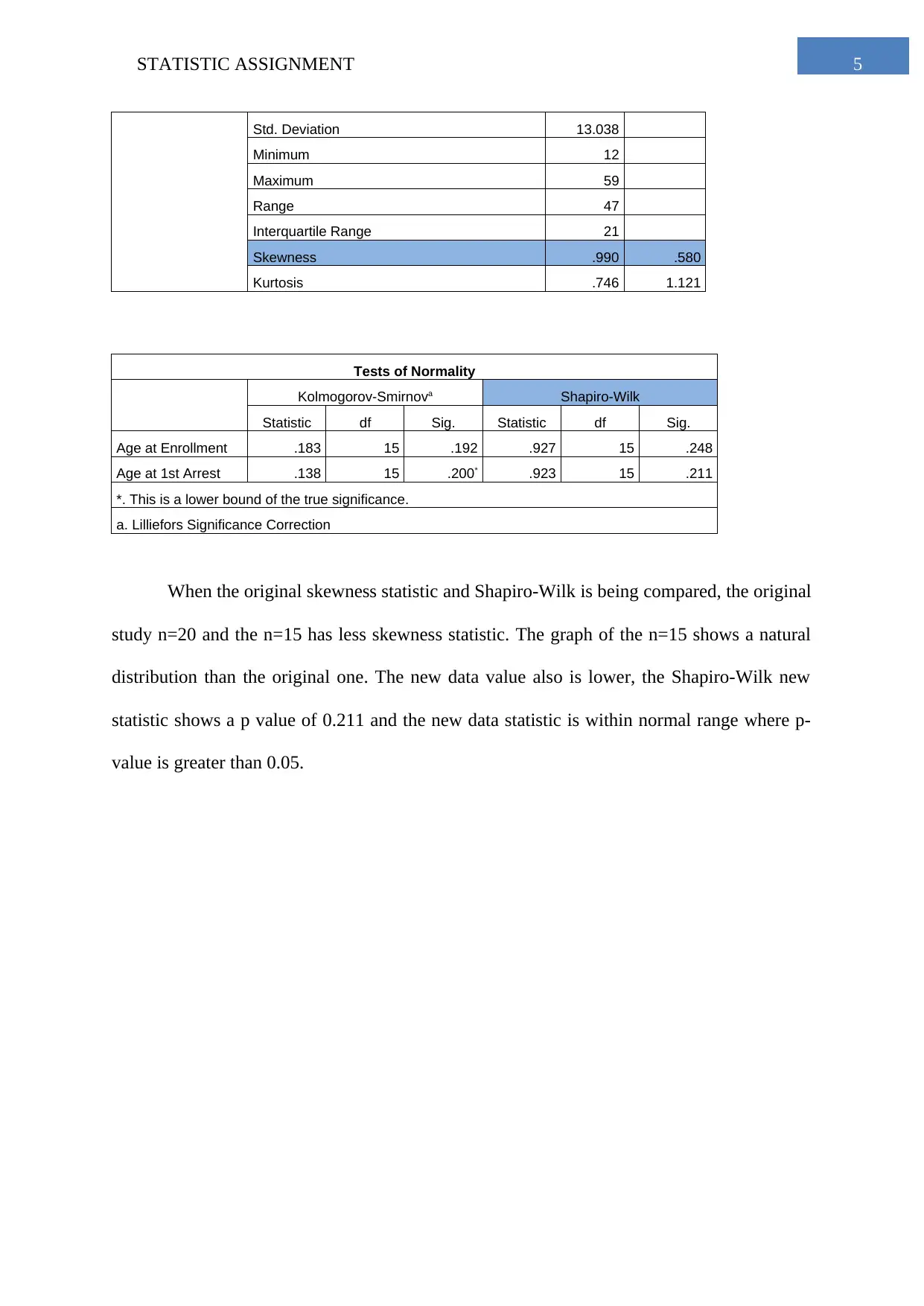
5STATISTIC ASSIGNMENT
Std. Deviation 13.038
Minimum 12
Maximum 59
Range 47
Interquartile Range 21
Skewness .990 .580
Kurtosis .746 1.121
Tests of Normality
Kolmogorov-Smirnova Shapiro-Wilk
Statistic df Sig. Statistic df Sig.
Age at Enrollment .183 15 .192 .927 15 .248
Age at 1st Arrest .138 15 .200* .923 15 .211
*. This is a lower bound of the true significance.
a. Lilliefors Significance Correction
When the original skewness statistic and Shapiro-Wilk is being compared, the original
study n=20 and the n=15 has less skewness statistic. The graph of the n=15 shows a natural
distribution than the original one. The new data value also is lower, the Shapiro-Wilk new
statistic shows a p value of 0.211 and the new data statistic is within normal range where p-
value is greater than 0.05.
Std. Deviation 13.038
Minimum 12
Maximum 59
Range 47
Interquartile Range 21
Skewness .990 .580
Kurtosis .746 1.121
Tests of Normality
Kolmogorov-Smirnova Shapiro-Wilk
Statistic df Sig. Statistic df Sig.
Age at Enrollment .183 15 .192 .927 15 .248
Age at 1st Arrest .138 15 .200* .923 15 .211
*. This is a lower bound of the true significance.
a. Lilliefors Significance Correction
When the original skewness statistic and Shapiro-Wilk is being compared, the original
study n=20 and the n=15 has less skewness statistic. The graph of the n=15 shows a natural
distribution than the original one. The new data value also is lower, the Shapiro-Wilk new
statistic shows a p value of 0.211 and the new data statistic is within normal range where p-
value is greater than 0.05.
⊘ This is a preview!⊘
Do you want full access?
Subscribe today to unlock all pages.

Trusted by 1+ million students worldwide
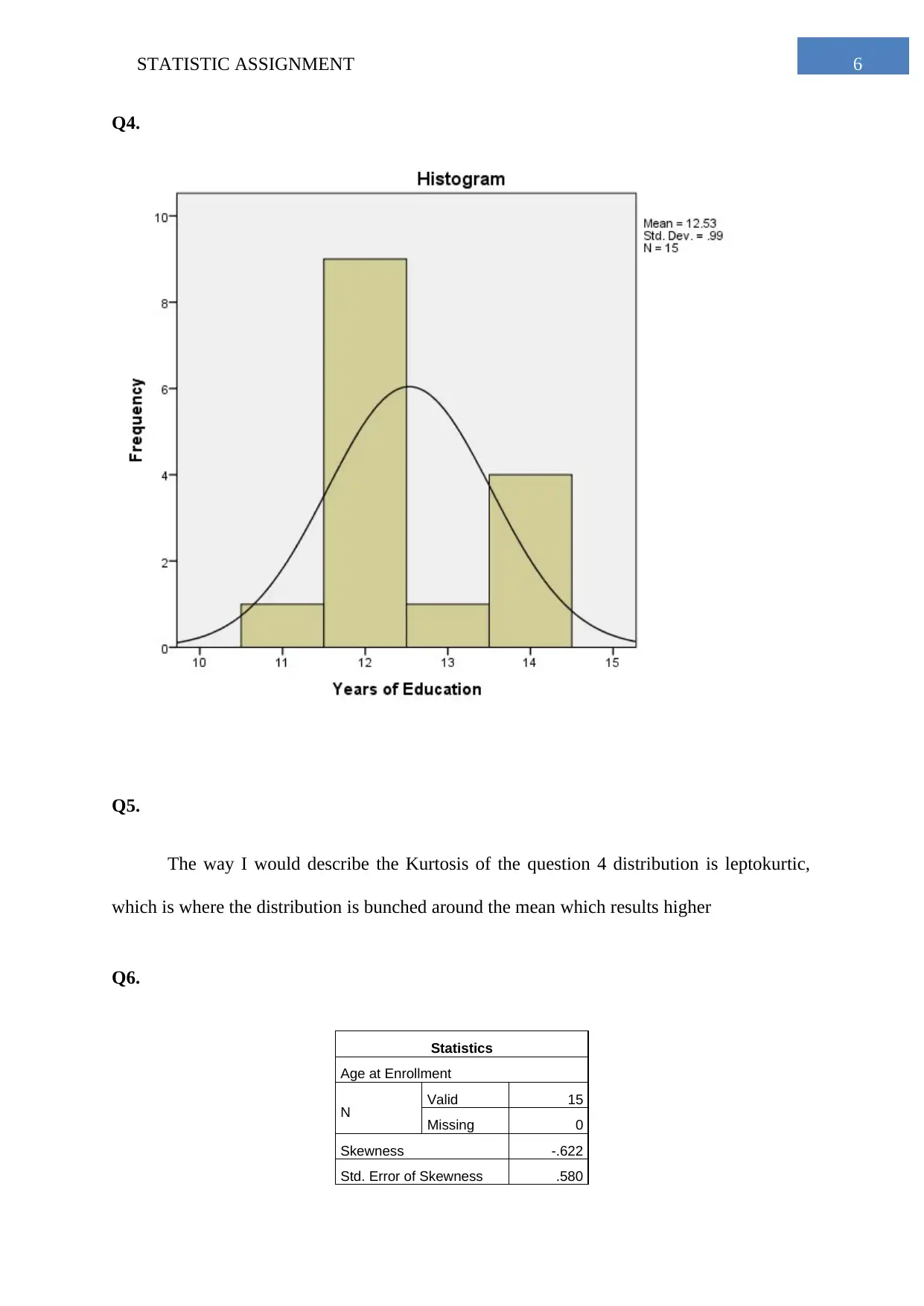
6STATISTIC ASSIGNMENT
Q4.
Q5.
The way I would describe the Kurtosis of the question 4 distribution is leptokurtic,
which is where the distribution is bunched around the mean which results higher
Q6.
Statistics
Age at Enrollment
N Valid 15
Missing 0
Skewness -.622
Std. Error of Skewness .580
Q4.
Q5.
The way I would describe the Kurtosis of the question 4 distribution is leptokurtic,
which is where the distribution is bunched around the mean which results higher
Q6.
Statistics
Age at Enrollment
N Valid 15
Missing 0
Skewness -.622
Std. Error of Skewness .580
Paraphrase This Document
Need a fresh take? Get an instant paraphrase of this document with our AI Paraphraser

7STATISTIC ASSIGNMENT
The Skewness statistic can be reviewed in the data below it is 0.622. a skewness that
is negative means most of statistic tail is on the left, which can be seen in the data below. The
table shows that the data is a little bit skewed because the value between -1 and -1/2 or 1 and
½ is moderate.
Q7.
The kurtosis for years of education is 0.936,
when a value is negative for a kurtosis it means the tail
of the statistic is light, and the data is mainly around
the mean. Meaning the magnitude is less than one, meaning the value of kurtosis is moderate.
Q8.
Tests of Normality
Kolmogorov-Smirnova Shapiro-Wilk
Statistic df Sig. Statistic df Sig.
Number of Times Fired from
Job .311 15 .000 .737 15 .001
a. Lilliefors Significance Correction
Using the SPSS with the Shapiro-Wilk it’s a test that diverge from a normal
distribution, meaning if a p value is less than 0.05 it can be used to verify if a distribution
is normal or not. In this example the value 0.001 meaning the number is not standard from
the amount of times getting tired from a job.
Statistics
Years of Education
N Valid 15
Missing 0
Skewness .658
Std. Error of Skewness .580
Kurtosis -.936
Std. Error of Kurtosis 1.121
The Skewness statistic can be reviewed in the data below it is 0.622. a skewness that
is negative means most of statistic tail is on the left, which can be seen in the data below. The
table shows that the data is a little bit skewed because the value between -1 and -1/2 or 1 and
½ is moderate.
Q7.
The kurtosis for years of education is 0.936,
when a value is negative for a kurtosis it means the tail
of the statistic is light, and the data is mainly around
the mean. Meaning the magnitude is less than one, meaning the value of kurtosis is moderate.
Q8.
Tests of Normality
Kolmogorov-Smirnova Shapiro-Wilk
Statistic df Sig. Statistic df Sig.
Number of Times Fired from
Job .311 15 .000 .737 15 .001
a. Lilliefors Significance Correction
Using the SPSS with the Shapiro-Wilk it’s a test that diverge from a normal
distribution, meaning if a p value is less than 0.05 it can be used to verify if a distribution
is normal or not. In this example the value 0.001 meaning the number is not standard from
the amount of times getting tired from a job.
Statistics
Years of Education
N Valid 15
Missing 0
Skewness .658
Std. Error of Skewness .580
Kurtosis -.936
Std. Error of Kurtosis 1.121
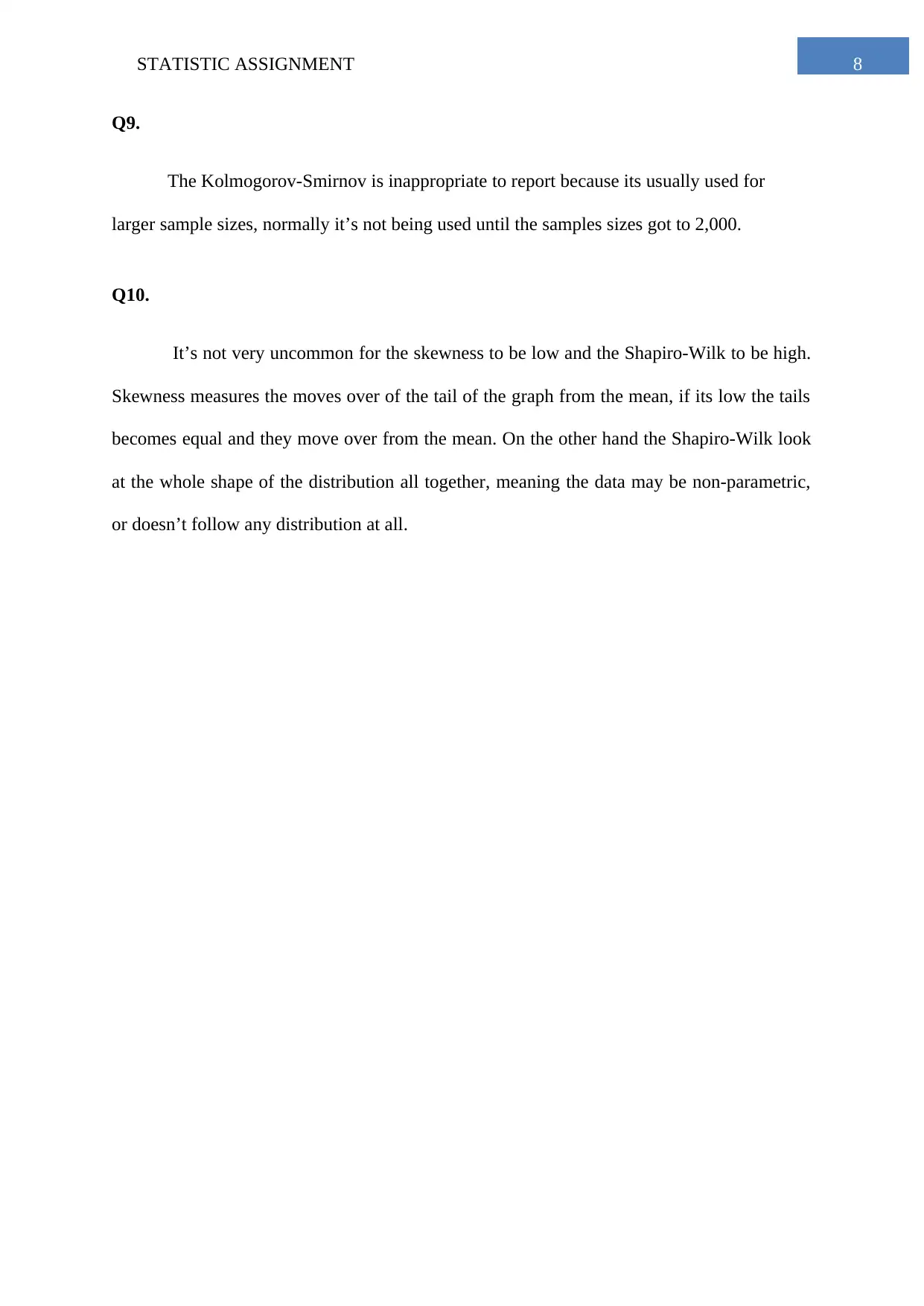
8STATISTIC ASSIGNMENT
Q9.
The Kolmogorov-Smirnov is inappropriate to report because its usually used for
larger sample sizes, normally it’s not being used until the samples sizes got to 2,000.
Q10.
It’s not very uncommon for the skewness to be low and the Shapiro-Wilk to be high.
Skewness measures the moves over of the tail of the graph from the mean, if its low the tails
becomes equal and they move over from the mean. On the other hand the Shapiro-Wilk look
at the whole shape of the distribution all together, meaning the data may be non-parametric,
or doesn’t follow any distribution at all.
Q9.
The Kolmogorov-Smirnov is inappropriate to report because its usually used for
larger sample sizes, normally it’s not being used until the samples sizes got to 2,000.
Q10.
It’s not very uncommon for the skewness to be low and the Shapiro-Wilk to be high.
Skewness measures the moves over of the tail of the graph from the mean, if its low the tails
becomes equal and they move over from the mean. On the other hand the Shapiro-Wilk look
at the whole shape of the distribution all together, meaning the data may be non-parametric,
or doesn’t follow any distribution at all.
⊘ This is a preview!⊘
Do you want full access?
Subscribe today to unlock all pages.

Trusted by 1+ million students worldwide
1 out of 9
Related Documents
Your All-in-One AI-Powered Toolkit for Academic Success.
+13062052269
info@desklib.com
Available 24*7 on WhatsApp / Email
![[object Object]](/_next/static/media/star-bottom.7253800d.svg)
Unlock your academic potential
Copyright © 2020–2025 A2Z Services. All Rights Reserved. Developed and managed by ZUCOL.





